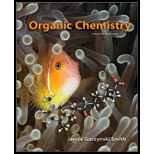
Concept explainers
A and B, isomers of molecular formula
a. Identify the structures of A and B from the following
Compound A: singlet at
Compound B: doublet at
b. What is the structure of C?
Want to see the full answer?
Check out a sample textbook solution
Chapter 15 Solutions
Organic Chemistry - With Access (Looseleaf) (Custom)
- 3-Chlorocyclopropene, on treatment with AgBF4, gives a precipitate of AgCl and a stable solution of a product that shows a single 1H NMR absorption at 11.04 δ. What is a likely structure for the products, and what is its relation to HĂ¼ckel’s rule?arrow_forwardAscaridole is a natural product that has been used to treat intestinal worms. Explain why the two methyls on the isopropyl group in ascaridole appear in its 1H-NMR spectrum as four lines of equal intensity, with two sets of two each separated by 7 Hz.arrow_forwardFollowing are 1H-NMR spectra for compounds G, H, and I, each with the molecular formula C5H12O. Each is a liquid at room temperature, is slightly soluble in water, and reacts with sodium metal with the evolution of a gas. (a) Propose structural formulas of compounds G, H, and I. (b) Explain why there are four lines between 0.86 and 0.90 for compound G. (c) Explain why the 2H multiplets at 1.5 and 3.5 for compound H are so complex.arrow_forward
- 3-Methyl-2-butanol has five signals in its 13C NMR spectrum at 17.90, 18.15, 20.00, 35.05, and 72.75 . Why are the two methyl groups attached to C3 nonequivalent? Making a molecular model should be helpful.arrow_forwardA 13C NMR spectrum of commercially available 2,4-pentanediol, shows five peaks at 23.3, 23.9, 46.5, 64.8, and 68.1 . Explain.arrow_forwardCompound F, a hydrocarbon with M+=96 in its mass spectrum, undergoes reaction with HBr to yield compound G. Propose structures for F and G, whose 13C NMR spectral data are given below. Compound F Broadband-decoupled 13C NMR: 27.6, 29.3, 32.2, 132.4 DEPT-90: 132.4 DEPT-135: positive peak at 132.4 ; negative peaks at 27.6, 29.3, 32.2 Compound G Broadband-decoupled 13C NMR: 25.1, 27.7, 39.9, 56.0 DEPT-90: 56.0 DEPT-135: positive peak at 56.0 ; negative peaks at 25.1, 27.7, 39.9arrow_forward
- For each compound shown below,(1) sketch the 13C NMR spectrum (totally decoupled, with a singlet for each type of carbon), showing approximatechemical shifts.(2) show the multiplicity expected for each signal in the off-resonance-decoupled spectrum.(3) sketch the spectra expected using the DEPT-90 and DEPT-135 techniques.(a)OCH3 C O CH2 CH3ethyl acetatearrow_forwardWhen 2-bromo-3,3-dimethylbutane is treated with K+ -OC(CH3)3, a single product T having molecular formula C6H12 is formed. When 3,3-dimethylbutan-2-ol is treated with H2SO4, the major product U has the same molecular formula. Given the following 1H NMR data, what are the structures of T and U? Explain in detail the splitting patterns observed for the three split signals in T.1H NMR of T: 1.01 (singlet, 9 H), 4.82 (doublet of doublets, 1 H, J = 10, 1.7 Hz), 4.93 (doublet of doublets, 1 H, J = 18, 1.7 Hz),and 5.83 (doublet of doublets, 1 H, J = 18, 10 Hz) ppm1H NMR of U: 1.60 (singlet) ppmarrow_forwardDraw an isomer of C4H9Cl that would be expected to have four resonances in its 13C NMR spectra.arrow_forward
- A and B, isomers of molecular formula C3H5Cl3, are formed by the radical chlorination of a dihalide C of molecular formula C3H6Cl2. a.Identify the structures of A and B from the following 1H NMR data: Compound A: singlet at 2.23 and singlet at 4.04 ppm Compound B: doublet at 1.69, multiplet at 4.34, and doublet at 5.85 ppm b.What is the structure of C?arrow_forwardA hydrocarbon, compound B, has molecular formula C6H6, and gave an NMR spectrum with two signals: delta 6.55 pm and delta 3.84 pm with peak ratio of 2:1. When warmed in pyridine for three hr, compound B quantitatively converts to benzene. Mild hydrogenation of B yielded another compound C with mass spectrum of m/z 82. Infrared spectrum showed no double bonds; NMR spectrum showed one broad peak at delta 2.34 ppm. With this information, address the following questions. a) How many rings are in compound C? b) How many rings are probably in B? How many double bonds are in B? c) Can you suggest a structure for compounds B and C? d) In the NMR spectrum of B, the up-field signal was a quintet, and the down field signal was a triplet. How must you account for these splitting patterns?arrow_forward1. Nomex is a flame resistant polymer developed by DuPont in the 1960s. Itis made by polymerizing benzene-1,3-diamine and isophthaloyl chloride. a) Draw three repeating units of Nomex. b) How many peaks will there be in the 1 H NMR spectrum of Nomex,assuming a polymer strand is infinitely long? c) How many peaks will there be in the 13 C NMR spectrum of Nomex,assuming a polymer strand is infinitely long?arrow_forward
 Organic ChemistryChemistryISBN:9781305580350Author:William H. Brown, Brent L. Iverson, Eric Anslyn, Christopher S. FootePublisher:Cengage Learning
Organic ChemistryChemistryISBN:9781305580350Author:William H. Brown, Brent L. Iverson, Eric Anslyn, Christopher S. FootePublisher:Cengage Learning

